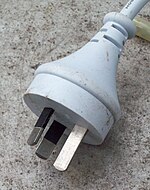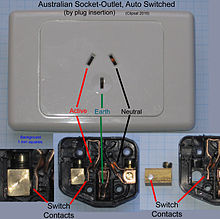AS/NZS 3112
In New Zealand, the voltage is 230 V. Fiji, Tonga and Papua New Guinea remains at a nominal 240 V, and in the Solomon Islands it is 220 V. The standards of China and Argentina also use the Type I plug and socket, though the live (active) and neutral pins are swapped in Argentina, and neither includes insulation on these prongs.
Differences in voltage may give rise to compatibility issues, especially for travellers and those purchasing appliances overseas or online.
Over time, Pacific Island countries that use AS/NZS standards will also transition to the newer voltage of 230 V.[original research?]
[7] By the early 1930s this design had been up-rated to 250 V 10 A capacity and Hubbell had supplied the Australian electrical industry with his sockets.
[15] A standard socket-outlet provides a nominal RMS voltage of 230 volts[2] at a maximum of 10 amps and always includes an earth connection.
If required, such dual socket-outlets can be obtained (at additional cost) using insulation displacement as a means of connecting to the supply conductors, as can be seen in the illustration – below right.
[16][17] The benefits claimed for their use in these applications include up to 50% faster installation, due to the reduction in the stripping, twisting and screwing down processes.
Exceptions could be devices such as illuminated "Exit" signs, which require connection to the power supply at all times.
[20] Double pole switches are required in caravans and mobile homes: Standard single phase 230 V domestic socket outlets in Australia and New Zealand are rated at 10 A.
A variant of the Australian standard 10 amperes plug has a socket on the back to allow connection of a second appliance to the same outlet.
The latter is rated at only 110 V (since certain [foreign] 110 V plugs could be inserted into the socket-outlet) and may be used on PAR 64 lights, where two 110 volt 1000 watt lamps are used in series.
Care should also be taken with the 10 A version with the round pin as physically compatible, but electrically incompatible NEMA 7–15 connector used for 277 V 15 A connections is encountered in commercial or industrial settings in the Americas.
In 1980, the International Electrotechnical Commission (IEC) rationalised the 220 V and 240 V nominal voltage levels around the world to a consistent 230 V. This rationalisation was ostensibly made to improve the economics of making appliances by allowing manufacturers to produce a range of items with a rated voltage of 230 V. Not all countries have yet converted to the new standard.
[28] The reason given for Queensland's decision to move was the increased use of grid-tied rooftop solar installations raising the grid voltage.
By lowering the voltage to 230 V, additional headroom of 960 megawatts was created to accommodate future residential power generation from rooftop solar.










